Bi2Te3 Topological Insulator for Domain-Wall Dark Pulse Generation from Thulium-Doped Fiber Laser
Abstract
1. Introduction
2. Materials and Methods
3. Results and Discussion
4. Conclusions
Author Contributions
Funding
Acknowledgments
Conflicts of Interest
References
- Mikulla, B.; Leng, L.; Sears, S.; Collings, B.C.; Arend, M.; Bergman, K. Broad-band high-repetition-rate source for spectrally sliced WDM. IEEE Photon. Technol. Lett. 1999, 11, 418–420. [Google Scholar] [CrossRef]
- McFerran, J.J. Échelle spectrograph calibration with a frequency comb based on a harmonically mode-locked fiber laser: A proposal. Appl. Opt. 2009, 48, 2752–2759. [Google Scholar] [CrossRef] [PubMed]
- Carruthers, T.F.; Duling, I.N. 10-GHz, 1.3-ps erbium fiber laser employing soliton pulse shortening. Opt. Lett. 1996, 21, 1927–1929. [Google Scholar] [CrossRef] [PubMed]
- Tiu, Z.C.; Tan, S.J.; Zarei, A.; Ahmad, H.; Harun, S.W. Nonlinear polarization rotation-based mode-locked Erbium-doped fiber laser with three switchable operation states. Chin. Phys. Lett. 2014, 31, 094206. [Google Scholar] [CrossRef]
- Eckstein, J.N.; Ferguson, A.I.; Hänsch, T.W. High-resolution two-photon spectroscopy with picosecond light pulses. Phys. Rev. Lett. 1978, 40, 847–850. [Google Scholar] [CrossRef]
- Emplit, P.; Hamaide, J.P.; Reynaud, F.; Froehly, C.; Barthelemy, A. Picosecond steps and dark pulses through nonlinear single mode fibers. Optics Communication. 1987, 62, 374–379. [Google Scholar] [CrossRef]
- Agrawal, G.P. Nonlinear Fiber Optics, 3rd ed.; Academic Press: San Diego, CA, USA, 2001. [Google Scholar]
- Zakharov, V.E.; Shabat, A.B. Interaction between solitons in a stable medium. Soviet Phys. 1973, 37, 823–828. [Google Scholar]
- Tang, D.Y.; Li, L.; Song, Y.F.; Zhao, L.M.; Zhang, H.; Shen, D.Y. Evidence of dark solitons in all-normal-dispersion-fiber lasers. Phys. Rev. A. 2013, 88, 013849. [Google Scholar] [CrossRef]
- Zian, C.T.; Arman, Z.; Sin, J.T.; Harith, A.; Sulaiman, W.H. Harmonic dark pulse emission in erbium-doped fiber laser. Chin. Phys. Lett. 2015, 32, 034203. [Google Scholar] [CrossRef]
- Zhang, H.; Tang, D.Y.; Zhao, L.M.; Wu, X. Dark pulse emission of a fiber laser. Phys. Rev. A 2009, 80, 045803. [Google Scholar] [CrossRef]
- Zhang, H.; Tang, D.Y.; Zhao, L.M.; Knize, R.J. Vector dark domain wall solitons in a fiber ring laser. Opt. Express 2010, 18, 4428–4433. [Google Scholar] [CrossRef] [PubMed]
- Malomed, B.A. Domain wall between traveling waves. Phys. Rev. E. 1994, 50, R3310–R3313. [Google Scholar] [CrossRef]
- Malomed, B.A. Optical domain walls. Phys. Rev. E 1994, 50, 1565–1571. [Google Scholar] [CrossRef]
- Tiu, Z.C.; Suthaskumar, M.; Zarei, A.; Tan, S.J.; Ahmad, H.; Harun, S.W. Generation of switchable domain wall and cubic–quintic nonlinear Schrödinger equation dark pulse. Opt. Laser Technol. 2015, 73, 127–129. [Google Scholar] [CrossRef]
- Ahmad, H.; Tiu, Z.; Zarei, A.; Suthaskumar, M.; Salim, M.A.M.; Harun, S.W. Domain-wall dark pulse generation in fiber laser incorporating MoS2. Appl. Phys. B. 2016, 122, 69–73. [Google Scholar] [CrossRef]
- Liu, J.; Li, X.; Zhang, S.; Zhang, H.; Yan, P.; Han, M.; Pang, Z.; Yang, Z. Polarization domain wall pulses in a microfiber-based topological insulator fiber laser. Sci. Rep. 2016, 6, 29128. [Google Scholar] [CrossRef] [PubMed]
- Guo, B.; Yao, Y.; Xiao, J.J.; Wang, R.L.; Zhang, J.Y. Topological insulator-assisted dual-wavelength fiber laser delivering versatile pulse patterns. IEEE J. Sel. Top. Quantum Electron. 2016, 22, 0900108. [Google Scholar] [CrossRef]
- Markom, A.M.; Tan, S.J.; Haris, H.; Paul, M.C.; Dhar, A.; Das, S.; Harun, S.W. Experimental Observation of Bright and Dark Solitons Mode-Locked with Zirconia-Based Erbium-Doped Fiber Laser. Chin. Phys. Lett. 2018, 35, 024203. [Google Scholar] [CrossRef]
- Liu, H.; Chow, K. Dark pulse generation in fiber lasers incorporating carbon nanotubes. Opt. Express. 2014, 22, 29708–29713. [Google Scholar] [CrossRef]
- Zhao, J.; Wang, Y.; Yan, P. An L-band graphene-oxide mode-locked fiber laser delivering bright and dark pulses. Laser Phys. 2013, 23, 075105. [Google Scholar] [CrossRef]
- Xiu, F.; He, L.; Wang, Y.; Cheng, L.; Chang, L.T.; Lang, M.; Huang, G.; Kou, X.O.; Zhou, Y.; Jiang, X.; et al. Manipulating surface states in topological insulator nanoribbons. Nat. Nano. 2011, 6, 216–221. [Google Scholar] [CrossRef] [PubMed]
- Hong, M.; Chasapis, T.C.; Chen, Z.G.; Yang, L.; Kanatzidis, M.G.; Snyder, G.J.; Zou, J. n-Type Bi2Te3−xSex Nanoplates with Enhanced Thermoelectric Efficiency Driven by Wide-Frequency Phonon Scatterings and Synergistic Carrier Scatterings. ACS Nano. 2016, 10, 4719–4727. [Google Scholar] [CrossRef] [PubMed]
- Wang, K.; Liu, Y.; Wang, W.; Meyer, N.; Bao, L.H.; He, L.; Lang, M.R.; Chen, Z.G.; Che, X.Y.; Post, K.; et al. High-quality Bi2Te3 thin films grown on mica substrates for potential optoelectronic applications. Appl. Phys. Lett. 2013, 103, 031605. [Google Scholar]
- Koo, J.; Lee, J.; Chi, C.; Lee, J.H. Passively Q-switched 1.56 μm all-fiberized laser based on evanescent field interaction with bulk-structured bismuth telluride topological insulator. J. Opt. Soc. Am. B 2014, 31, 2157–2162. [Google Scholar] [CrossRef]
- Lee, J.; Koo, J.; Jhon, Y.M.; Lee, J.H. A femtosecond pulse erbium fiber laser incorporating a saturable absorber based on bulk-structured Bi2Te3 topological insulator. Opt. Express. 2014, 22, 6165–6173. [Google Scholar] [CrossRef] [PubMed]
- Chen, Y.; Zhao, C.; Chen, S.; Du, J.; Tang, P.; Jiang, G.; Zhang, H.; Wen, S.; Tang, D. Large energy, wavelength widely tunable, topological insulator Q-switched erbium-doped fiber laser. IEEE J. Sel. Top. Quantum Electron. 2014, 20, 0900508. [Google Scholar]
- Lee, J.; Lee, J.; Koo, J.; Lee, J.H. Graphite saturable absorber based on the pencile-sketching method for Q-switching of an erbium fiber laser. Appl. Opt. 2016, 55, 303–309. [Google Scholar] [CrossRef] [PubMed]
- Kharitonov, S.; Billat, A.; Brès, C.-S. Kerr nonlinearity and dispersion characterization of core-pumped thulium-doped fiber at 2 μm. Opt. Lett. 2016, 41, 3173–3176. [Google Scholar] [CrossRef] [PubMed]
- Ciąćka, P.; Rampur, A.; Heidt, A.; Feurer, T.; Klimczak, M. Dispersion measurement of ultra-high numerical aperture fibers covering thulium, holmium, and erbium emission wavelengths. J. Opt. Soc. Am. B 2018, 8, 1301–1307. [Google Scholar] [CrossRef]
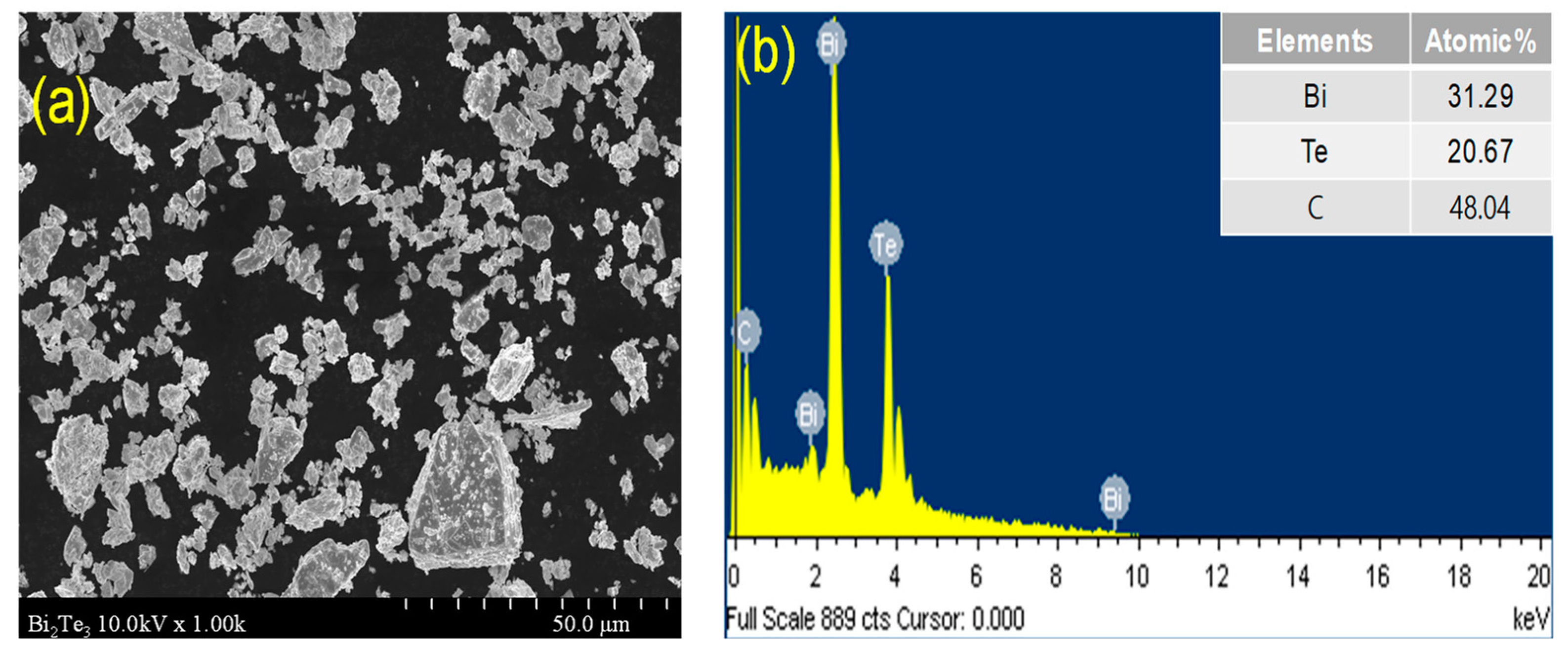
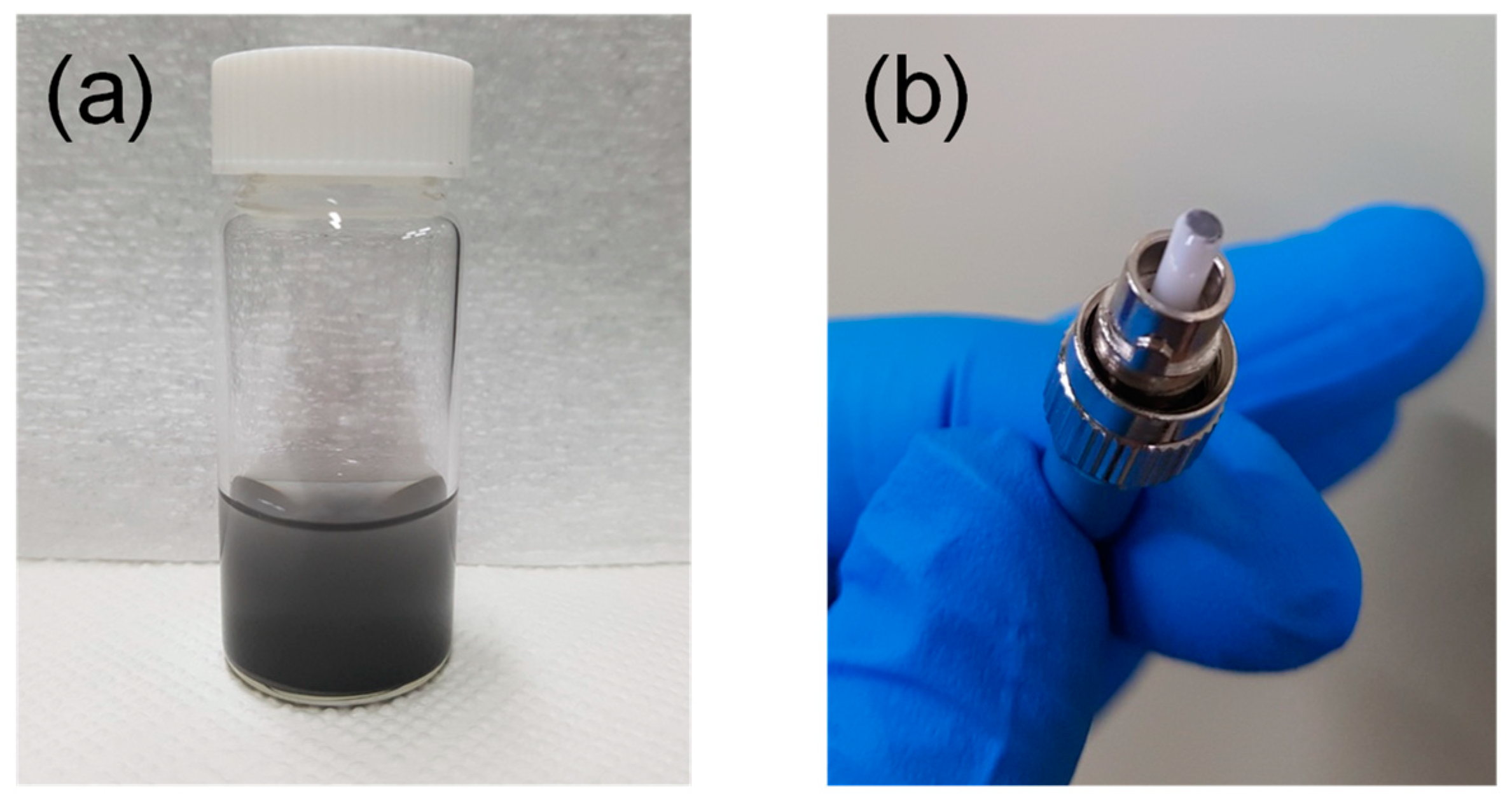
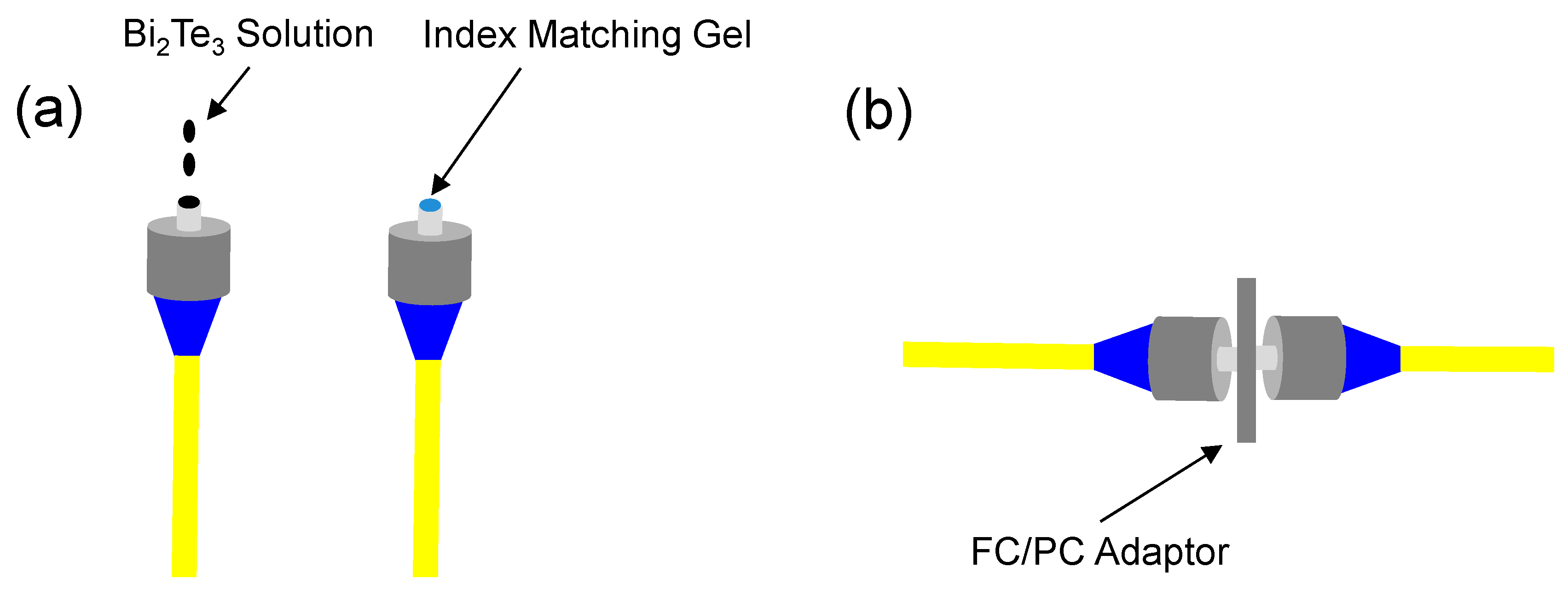
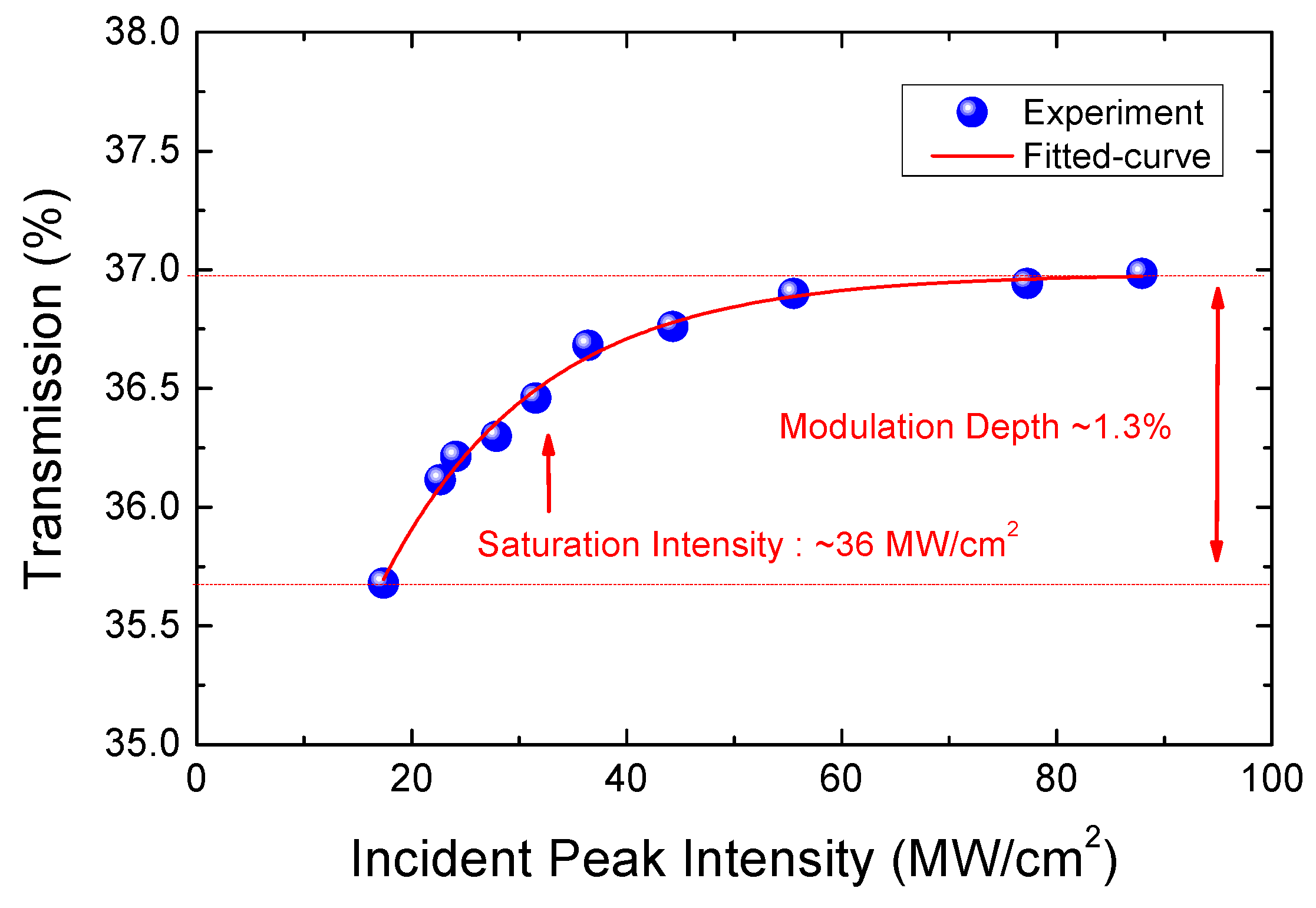

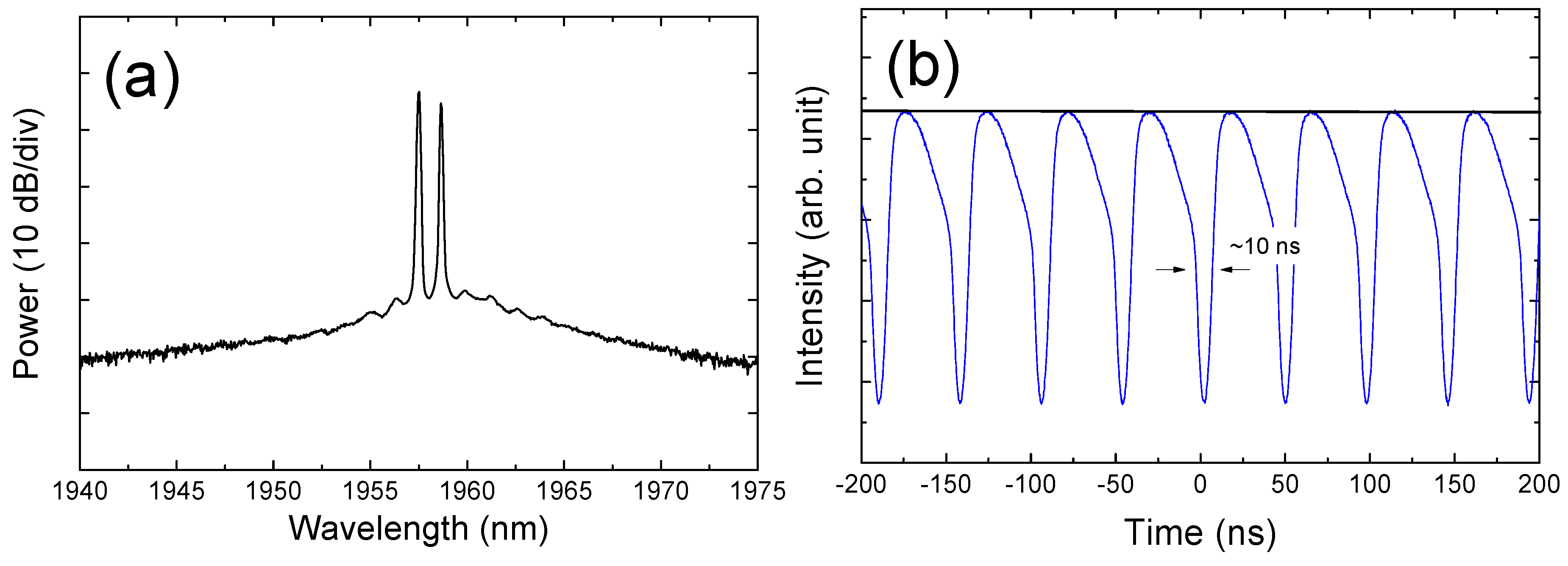
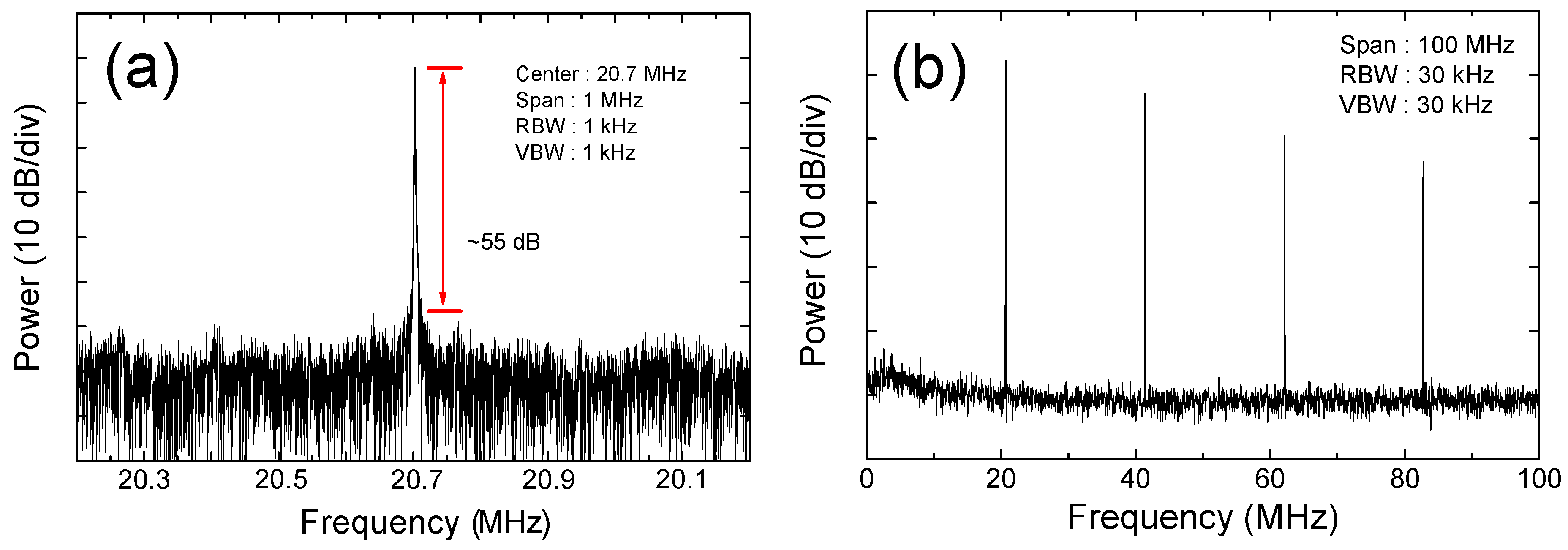
© 2019 by the authors. Licensee MDPI, Basel, Switzerland. This article is an open access article distributed under the terms and conditions of the Creative Commons Attribution (CC BY) license (http://creativecommons.org/licenses/by/4.0/).
Share and Cite
Koo, J.; Ashok, N.; Kim, D.H.; Shin, W. Bi2Te3 Topological Insulator for Domain-Wall Dark Pulse Generation from Thulium-Doped Fiber Laser. Crystals 2019, 9, 337. https://doi.org/10.3390/cryst9070337
Koo J, Ashok N, Kim DH, Shin W. Bi2Te3 Topological Insulator for Domain-Wall Dark Pulse Generation from Thulium-Doped Fiber Laser. Crystals. 2019; 9(7):337. https://doi.org/10.3390/cryst9070337
Chicago/Turabian StyleKoo, Joonhoi, Nandam Ashok, Dong Hwan Kim, and Woojin Shin. 2019. "Bi2Te3 Topological Insulator for Domain-Wall Dark Pulse Generation from Thulium-Doped Fiber Laser" Crystals 9, no. 7: 337. https://doi.org/10.3390/cryst9070337
APA StyleKoo, J., Ashok, N., Kim, D. H., & Shin, W. (2019). Bi2Te3 Topological Insulator for Domain-Wall Dark Pulse Generation from Thulium-Doped Fiber Laser. Crystals, 9(7), 337. https://doi.org/10.3390/cryst9070337



